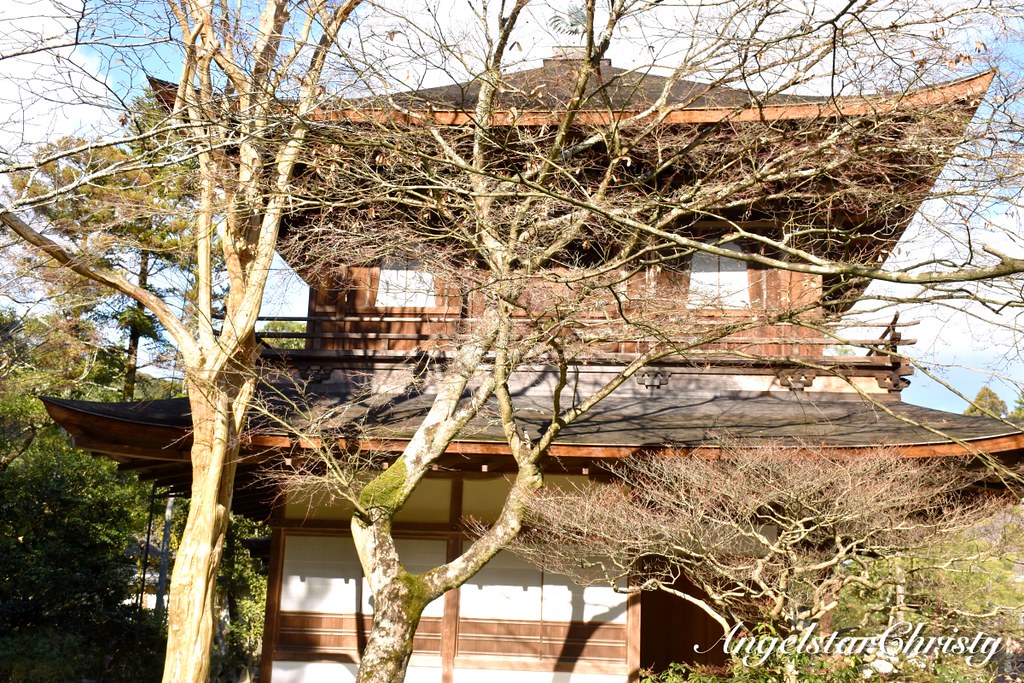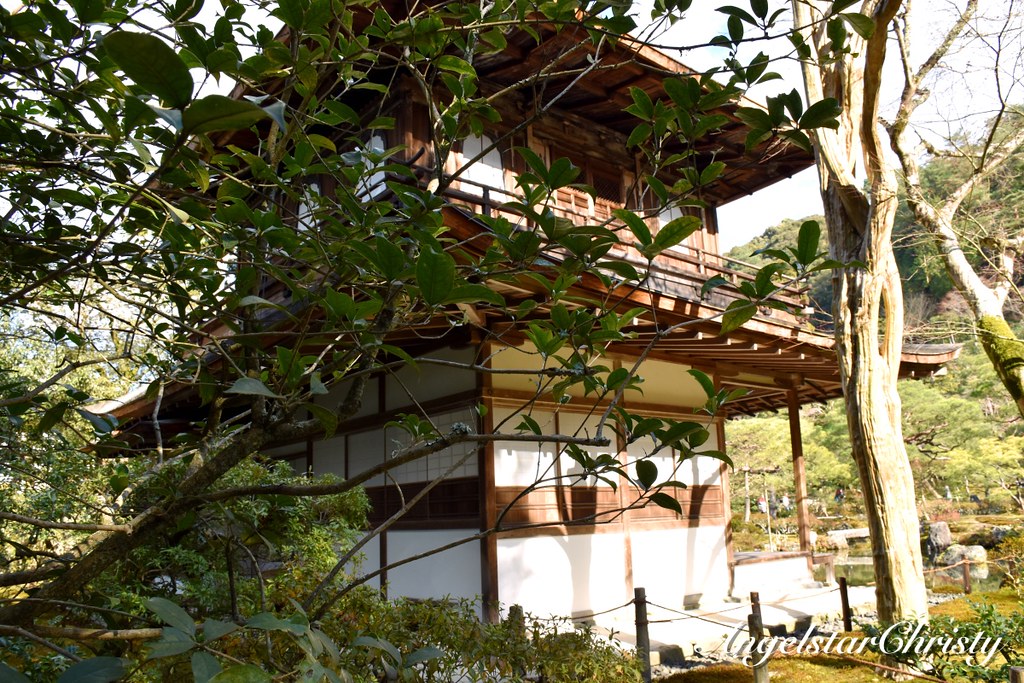
If you find yourself wondering if you have arrived at the wrong place upon reaching Ginkakuji (or Ginkaku-ji); also known as the famous Silver Pavilion Temple, you are not alone and be assured that there was nothing wrong with your sense of direction.
One cannot help but notice the temple's building is far from the glistening image which would probably pop up in the mind upon hearing that name.
Silver Pavilion, the name hints at and gives the impression that it must definitely be adorned with even a streak of that glistening silver if not cloaked in entirety.
Yet, staring at the whole temple, you won't be able to find anything resembling silver or even a tint that would return that sparkle in reflection upon the touch from the mighty sun.
Expectations fade and disappointment creeps in; maybe even feelings of deception seep in amidst all that dismay as the image of grandeur and glitter disappears altogether.
Standing before the building, it looks just like any other place of worship; ordinary, plain and undeserving of its status as one of the World Heritage Sites, or even placed on the list of the national treasury.

But above all, the question remains, where is the silver in the so-called Silver Pavilion?
Perhaps one may even wonder if it is even worth a visit, or spending time on, and should one give it a miss and divert to other places of attraction to make the most of the hectic and constraining traveling/visiting schedule while in Kyoto.
It is not a mistake, and beyond all that facade, the silver is not easily spotted but rather to be uncovered by one as we explore the modest building.
It all goes back to a unfulfilled objective from the beginning; when the notion of the place was conceived and the fault of the non-existent silver could be pinned to the late Ashikaga Yoshimasa; an influential shogun of his time (1435-1490).
It was no coincidence that he was the grandson of the late Ashikaga Yoshimitsu; the man behind the glittering Golden Pavilion, or known as Kinkakuji (mentioned in my previous post).
In fact, Ginkakuji was to replicate the same model of Kinkakuji; only instead of gold, Yoshimasa decided to go for silver.
That is, to cover the exterior of the temple with silver foil.
Ginkakuji was meant to be a retirement villa initially; as Yoshimasa had intended, taking after his grandfather's idea for Kinkakuji as well, following after his death would be then converted into a place of worship.
The entire Ginkakuji was remodeled after its golden predecessor, and it would have been erected according to the original plan had it not been for the interruption from the depressing Onin War; a decade long war which was most eminent in Kyoto's history as it almost wiped out the entire city.
Yoshimasa may be to blame as well, for both the halt in Ginkakuji's construction and for the occurrence of Onin War(1467-1477).
Though a renowned shogun with power and wealth, Yoshimasa lacked in political skills and strategy and possibly contributed to the war with the internal conflict caused by his decision to appoint his brother as a shogun then reverted to install his own son instead.
Yoshimasa never saw the realization of his plan to create the Silver Pavilion, and neither did we.
He retreated from politics and chose to spend his time in relaxation, discovering his artful talent as he was recognized as one who helped propagate the art of tea ceremony to the next level and simply, made quite an artwork out of the whole tea ceremony concept; one that continued to influence until this very day.
Though the silver part was never actualized, Ginkakuji boasts of more than a dozen buildings on its grounds; all of which were personally supervised by Yoshimasa during its construction.
In fact, the gardens of Ginkakuji are also part of what makes up the beauty of the establishment, with its many features fortifying the charisma of temple.
It is not just the main temple that deserves the attention, but rather the overall complex and all that decorate the vast grounds; noticeable from the moment one enters the compound.
The simple two-storey temple building is a fine mark of the Higashiyama culture; one that adopts and combines Chinese architectural design elements with the developing Japanese Muromachi style, prominent during the period named after the latter - the Muromachi Period.

The humble wooden exterior houses the former residence of Yoshimasa on the lower floor; where he spends his time enjoying his tea ceremony art in the rear hall; known as Dojin-sai (translated as Comradely Abstinence).
The hall sets the standard and serves as the blueprint for all tea ceremony halls since then till today.
The front hall, the Togu-Do (East Seeking Hall) is listed as a National Treasure and housed not only Yoshimasa's place of residence but also a statue of a priest; believed to be a replica of the shogun (Yoshimasa) himself.


Like Kinkakuji, the upper floor abodes a golden statue of the deity Kannon (Goddess of Mercy).
Ginkakuji was converted into a temple; or a zen-based place of worship following the passing of Yoshimasa; as according to the shogun's will, a common practice at that time.
Officially, the place is known as Jisho-ji((慈照寺), or the Temple of Shining Mercy though it was its original name which stuck with the local population and tourists alike, despite the missing silver exterior as its name suggests.
Ginkakuji(銀閣寺), or the Temple of the Silver Pavilion was the name which was popular during the Edo period, but perhaps it was the link to the golden predecessor in Kinkakuji, Ginkakuji continued to be name on everyone's mouth for generations.
It is not only the main temple, or the pavilion which is the star attraction, but the gardens are equally as fascinating.
That is where the silver part of the temple comes about, or so they say.
The reflection of the silver lacquer finish from the glistening waters of the pond; returning a glint of silver back at the wooden building.
It probably is viewed beyond just the naked eye, if you may.
The gardens are worth exploring; with the segregation into two different styles as with most Japanese gardens.
While one is made of cutting rocks and reflecting water, sectioned into multiple viewpoints for a distinctive perspective of the temple; the other is the one which greets one at the entrance and trails throughout the grounds, made of mounds of sand to take on the shape of Mount Fuji for one and the art form which made up the Sea of Silver Sand.





So it is technically not wrong for Ginkakuji to continue to take on the suggestive name of silver, despite its non-existent tint in the exterior for it is all about that invisible silver lining which one would need beyond their naked eyes and direct perception to discover.
After all, not everything is as it seems; or rather as they appears in flesh.
Often than not, we tend to only view and judge skin-deep or easily misled by the appearance without further exploration.
We fall for the surface despite knowing that beauty is only skin deep, but being the superficial and visual lots we are, we still constantly fall for that outer appearance.
Sometimes, all it needs is a second take and to view beyond what the eyes can see, for not everything is straightforward or evident immediately at a glance.
Ginkakuji is an interesting reminder of that lesson; of how we often missed the silver lining when we walk away at the first glance.

It is not always about the exterior, for often it is the essence and the substance that matters and that is the silver hidden within this zen temple.
I am glad I found it, and continue to revel in the simplicity and artistic nature of the place which lingers on long after the visit.
It may not be the same experience for everyone, and I am not saying it to promote the temple for I am in no way associated to them, but rather, it is a beautiful yet subtle reminder of a lesson on looking beyond the surface.
There may not be silver where it is mentioned, or can be seen, but it doesn't mean the silver is non-existent at all.
It may not be a silver temple as its name suggests, but it doesn't mean there is no silver at all within the temple and its grounds.
All it takes is to look for that silver lining; no matter how tiny that streak may be, and it is not all about the visible cloak of silver foil.
That is the silver of Ginkakuji; that unseen silver lining lying beneath its exterior, waiting to be discovered.
Yoshimasa would be proud, I am sure.


Information:
Ginkakuji(銀閣寺)/Temple of the Silver Pavilion
Official name:
Jisho-ji (慈照寺)/Temple of the Shining Mercy
Address:
2 Ginkakujicho, Sakyo Ward, Kyoto, Kyoto Prefecture 606-8402, Japan
Admission Fees: 500 Yen per person (kindly refer to the official website for confirmation)
Opening Hours: (Open Daily)
Mid-March-November: 8.30am-5.00pm
December-March: 9.00am-4.30pm
You do not have to agree with me.
Art Direction and Photography Styling by Me.
Photos/Videos all belong to me and are copyrighted.
Please kindly ask for permission if you need to use any of my images.
Check out my Pinterest @Angelstarc
Follow me on my live updates on my life, happening on SNAPCHAT @angelstarchrist



0 comments